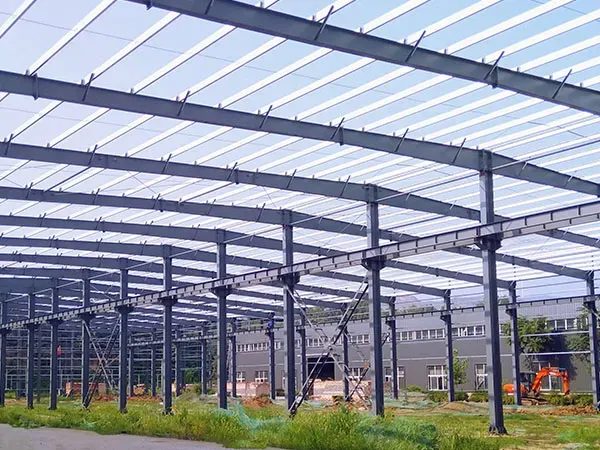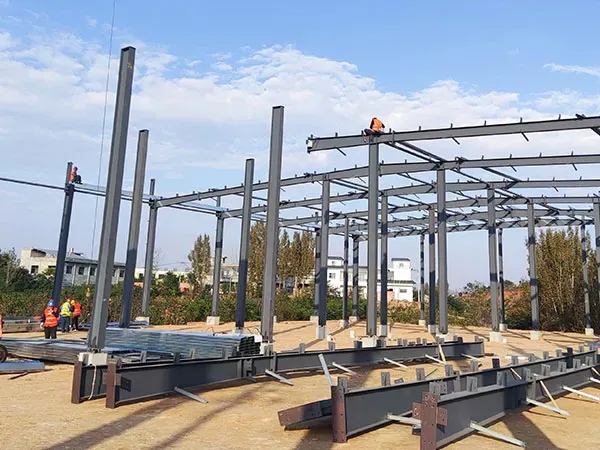Time:2025-03-05 02:55:52 Source:Sanjian Meichen Steel Structure
In today's rapidly developing modern agriculture, efficient, sustainable, and cost-effective agricultural infrastructure is crucial for success. Steel structures are becoming an increasingly integral component of the agricultural sector. From expansive farm warehouses to advanced greenhouses and livestock facilities, they are revolutionizing agricultural production with their superior performance and unparalleled advantages. This article will delve into the many benefits of using steel structures in agriculture, revealing why they are the ideal choice for agricultural producers worldwide.
1. Superior Strength and Durability: A Guardian Against Harsh Environments
Agricultural environments are often challenging, with extreme weather conditions (such as strong winds and heavy snow) as well as everyday wear and tear placing high demands on the strength of buildings. Steel structures, with their high strength-to-weight ratio, can easily withstand these harsh conditions.
Resistant to Natural Disasters: Steel's ductility and strength make it highly resistant to extreme natural disasters such as earthquakes, hurricanes, and tornadoes, providing reliable protection for crops, livestock, and equipment. Long Service Life: Properly treated steel structures offer excellent corrosion resistance, are less susceptible to pests, and, unlike wood, won't rot, warp, or crack. This means a longer building lifespan, reducing long-term maintenance and replacement costs and conserving valuable resources for farmers.
2. Cost-Effectiveness: Smart Investment, Generous Returns
Against the backdrop of shrinking agricultural profit margins, cost control is a key concern for every agricultural operator. Steel structures offer significant cost advantages in several areas.
Quick Construction, Labor Savings: Steel structures are typically prefabricated in a factory and require only on-site assembly. This modular construction method significantly shortens the construction cycle, reduces on-site labor requirements, and reduces associated costs.
Low Maintenance: Steel structures are durable and resistant to damage, making ongoing maintenance costs significantly lower than other traditional building materials. For example, they require less frequent painting or anti-corrosion treatment, reducing both time and money.
Potentially Lower Insurance Costs: Due to the greater fire and disaster resistance of steel structures, some insurance companies may offer more favorable premiums, further reducing operating costs.
3. Design Flexibility and Scalability: Meeting the Diversifying Needs of Agriculture
Modern agricultural production models are becoming increasingly diverse, placing increasingly complex demands on building structures and spatial requirements. Steel structures offer unparalleled design freedom.
Long-Span, Column-Free Spaces: Steel structures enable long-span, column-free interior spaces, which are crucial for agricultural buildings that require flexible layouts and large machinery operations, such as barns, machinery sheds, and livestock housing.
Easy to Expand and Modify: As agricultural production scale changes or technology upgrades, steel structures can be relatively easily expanded, modified, or reconfigured to accommodate new needs, greatly facilitating future farm development.
Versatile Applications: Whether constructing storage facilities, processing plants, feed sheds, poultry houses, or high-tech greenhouses, steel structures offer customized solutions perfectly suited to a variety of agricultural applications.

4. Environmental Sustainability: The Path to Green Agriculture
Amidst the growing global focus on sustainable development, steel structures are demonstrating unique advantages in environmental protection. Recyclability: Steel is 100% recyclable and can be recycled an unlimited number of times after a building's lifecycle without losing its inherent physical properties, thus reducing resource consumption and waste generation.
Reduced Construction Waste: The prefabricated nature of steel structures means less construction waste is generated on-site, further minimizing environmental impact.
Energy Savings: By integrating efficient insulation materials, steel buildings can achieve excellent thermal insulation, reducing heating and cooling energy consumption and thus reducing carbon emissions.
5. Fire Safety: Protecting Life and Property
Fire is a potential threat to agricultural production, potentially resulting in significant economic losses and loss of life. Steel structures offer exceptional fire resistance.
Non-Combustible Material: Steel is inherently non-combustible and will not burn or support combustion, even at high temperatures.
High-Temperature Resistance: While extreme temperatures can cause steel to soften, proper fire-resistant coatings and design can significantly improve its fire resistance, buying valuable time for evacuation and property protection.
6. Hygiene and a Healthy Environment: Improving Agricultural Production Efficiency and Quality
Maintaining a clean and hygienic environment is crucial in livestock farming and agricultural product processing. Steel structures offer significant advantages in this regard.
Easy to Clean and Disinfect: The smooth surface of steel structures is less susceptible to the growth of bacteria, mold, and pests, making them easy to clean and disinfect, helping to maintain a high standard of hygiene. They are particularly suitable for farms, dairy processing plants, and other areas.
Improving Air Quality: Combined with a good ventilation system, steel structures can effectively improve internal air quality, providing a healthier and more comfortable environment for livestock, thereby improving production efficiency and product quality.
7. Rapid Market Responsiveness: Seizing Fleeting Business Opportunities
In the rapidly changing agricultural market, the ability to quickly build or renovate facilities to adapt to new demands is key to winning the competition.
Shortening Project Cycles: The rapid construction capability of steel structures means farmers can bring new facilities online more quickly, offering significant advantages whether responding to seasonal demand or capitalizing on market opportunities.

Smart Greenhouses and Bulk Grain Silos
Steel structures provide flexible spatial layouts and efficient working environments in the construction of smart greenhouses and 10,000-ton grain silos, meeting the diverse facility needs of modern agriculture.
Farms and Agricultural Product Processing Centers
Steel structures can be used to build standardized farms and agricultural product processing centers, improving production efficiency and product quality and promoting the industrialization of agriculture.
Future Outlook: Steel Structures Lead New Trends in Agricultural Architecture
With the advancement of agricultural modernization, steel structures, due to their high strength, modularity, and sustainability, are becoming the mainstream choice for future agricultural construction. The appropriate selection of different types of steel structures can maximize their advantages in modern agriculture and promote the upgrading of agricultural infrastructure.
In summary, steel structures in the agricultural sector have become a preferred option for modern agricultural infrastructure construction due to their unparalleled strength, durability, cost-effectiveness, design flexibility, environmental sustainability, superior fire safety, and hygienic advantages. They not only provide solid and reliable protection for crops, livestock, and equipment, but also contribute significantly to the sustainable development of global agriculture by optimizing operating costs, improving production efficiency, and ensuring food safety. When you invest in steel structures, you invest in the future of agriculture—a future that is smarter, more efficient, and more sustainable.